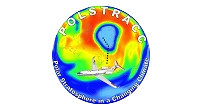Scientific objectives: Difference between revisions
From Polstracc
Content deleted Content added
m Anpassung Überschrift |
No edit summary |
||
| Line 1: | Line 1: | ||
== |
== Key issues adressed by POLSTRACC are: == |
||
* The structure of Arctic LMS: How large are the contributions of (ii) polar vortex air, (ii) extra-vortex stratospheric air and (iii) tropospheric air? |
|||
* The outflow of the polar vortex: How much vortex air descends through the bottom of the polar vortex during the course of the winter? To which extend are the chemical composition and the radiative balance of the surrounding LMS and the adjacent tropopause region affected? How efficient are stratosphere-troposphere exchange processes in the Arctic? |
|||
* Arctic cirrus clouds: To which extend do cirrus clouds around the Arctic tropopause and LMS region disturb chemical budgets (especially ozone) through heterogeneous reactions? Which role do cirrus clouds play in chlorine activation? How are the the budgets of water vapour and reactive nitrogen are affected by dehydration and denitrification through cirrus cloud particles? |
|||
* Polar stratospheric clouds (PSCs): How deep do polar stratospheric clouds pentrate into the lower stratosphere region? How strong is the LMS region disturbed by renitrification of nitric acid trihydrate (NAT) particles? How strong is the linkage between the occurence of PSCs and tropospheric clouds? |
|||
* Gravity waves: How do gravity waves affect the stability of the Arctic polar vortex? |
|||
* Role of the Arctic LMS and tropopause region in climate: How sensitive is the climate to changes in the chemical composition of this region? What are the dominant processes affecting ozone in this vertical range? How will the extent of Arctic cirrus cloud and PSC formation evolve in future and what are the consequences? |
|||
*To monitor in a changing climate the spatial and temporal variability of trace constituents, incl. aerosols, in the lowermost stratosphere during several phases of the polar winter ; assess trace gas budgets etc. |
*To monitor in a changing climate the spatial and temporal variability of trace constituents, incl. aerosols, in the lowermost stratosphere during several phases of the polar winter ; assess trace gas budgets etc. |
||
| ⚫ | |||
| ⚫ | |||
*To complement in a synergetic way satellite observations with dedicated field measurements |
|||
*To better understand changes in the ozone layer in a changing climate (subject of several HALO, national and EU initiatives) |
|||
*To improve the predictive capabilities on the development of the ozone layer in the coming 50 years |
|||
*To test precursors for future satellite experiments |
|||
[[Category:One]] |
[[Category:One]] |
||
Revision as of 18:06, 11 July 2013
Key issues adressed by POLSTRACC are:
- The structure of Arctic LMS: How large are the contributions of (ii) polar vortex air, (ii) extra-vortex stratospheric air and (iii) tropospheric air?
- The outflow of the polar vortex: How much vortex air descends through the bottom of the polar vortex during the course of the winter? To which extend are the chemical composition and the radiative balance of the surrounding LMS and the adjacent tropopause region affected? How efficient are stratosphere-troposphere exchange processes in the Arctic?
- Arctic cirrus clouds: To which extend do cirrus clouds around the Arctic tropopause and LMS region disturb chemical budgets (especially ozone) through heterogeneous reactions? Which role do cirrus clouds play in chlorine activation? How are the the budgets of water vapour and reactive nitrogen are affected by dehydration and denitrification through cirrus cloud particles?
- Polar stratospheric clouds (PSCs): How deep do polar stratospheric clouds pentrate into the lower stratosphere region? How strong is the LMS region disturbed by renitrification of nitric acid trihydrate (NAT) particles? How strong is the linkage between the occurence of PSCs and tropospheric clouds?
- Gravity waves: How do gravity waves affect the stability of the Arctic polar vortex?
- Role of the Arctic LMS and tropopause region in climate: How sensitive is the climate to changes in the chemical composition of this region? What are the dominant processes affecting ozone in this vertical range? How will the extent of Arctic cirrus cloud and PSC formation evolve in future and what are the consequences?
- To monitor in a changing climate the spatial and temporal variability of trace constituents, incl. aerosols, in the lowermost stratosphere during several phases of the polar winter ; assess trace gas budgets etc.
- To provide global models with accurate data from the deployments to refine their algorithms; to investigate whether the models can reproduce the spatial an temporal changes on ozone and relevant trace gases
